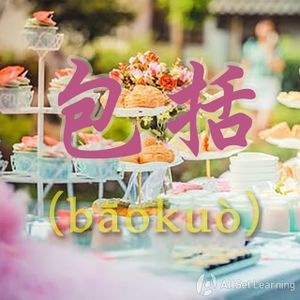Difference between revisions of "Expressing "including" with "zainei""
| Line 51: | Line 51: | ||
[[Category:B1 grammar points]] | [[Category:B1 grammar points]] | ||
| − | {{Basic Grammar|包括|B1|Subj. + 包括 + Obj.1 ( | + | {{Basic Grammar|包括|B1|Subj. + 包括 + Obj.1 (Obj.2, Obj.3⋯⋯ ) |他 说 “咱们”,当然 <em>包括</em> 你 。|grammar point|ASG50341}} |
{{Similar|}} | {{Similar|}} | ||
{{POS|Verbs}} | {{POS|Verbs}} | ||
Revision as of 03:43, 9 October 2017
| This article is a stub. Editors can help the Chinese Grammar Wiki by expanding it. |
"包括"本身可以做动词,宾语可以是一个,也可以列举多个。此外,"包括"也可以放在句首作状语,相当于英文的"including"。
Contents
Basic Usage
Structure
Subj. + 包括 + Obj.1 ( Obj.2, Obj.3 ⋯⋯)
Examples
- 他 说 “咱们”,当然 包括 你 。He said "us". That certainly includes you.
- 我 每 个 月 的 房租 不 包括 水 电 费 。My monthly rent does not include my water and electric bill.
- 公司 的 福利 包括 很 多 方面。The company's welfare benefits includes many aspects.
- 他 对 很 多 话题 都 很 感兴趣,包括 政治。He finds many topics of conversation interesting, including politics.
- 简历 一般 包括 个人 信息,教育 背景,工作 经历 等。A résumé generally includes a person's information, education background, work experience, etcetera.
Using 包括 with 在内
在英文里,状语的位置通常比较灵活,如"包括"就常常放在句尾,表示补充。但在汉语里,"包括"只能在放在句首,一般会跟"在内"和"一共"连用,口语中"在内"、"一共"是可以省略的。
Structure
包括 + Obj. (+ 在内),一共 ⋯⋯
Examples
- 包括 税,两 张 机票 一共 是 五千 。 Including taxes, two airplane tickets all together are $5,000.
- 包括 我 在内,一共 有 十五 个 人 参加 这个 会议 。Including myself, 15 people total participated in this meeting.
- 包括 奖金 在内,这个 月 我 拿 了 一万 块 钱 工资。Including bonuses, this month I received a salary of 1,000 RMB.
- 包括 母语 在内,他 一共 会 说 四 种 语言。Including my native language, I can speak a total of 4 languages.
- 包括 每 个 月 的 物业 费,我们 办公室 的 租金 是 两 万 。Including monthly property fees, our office's rent is $20,000.




